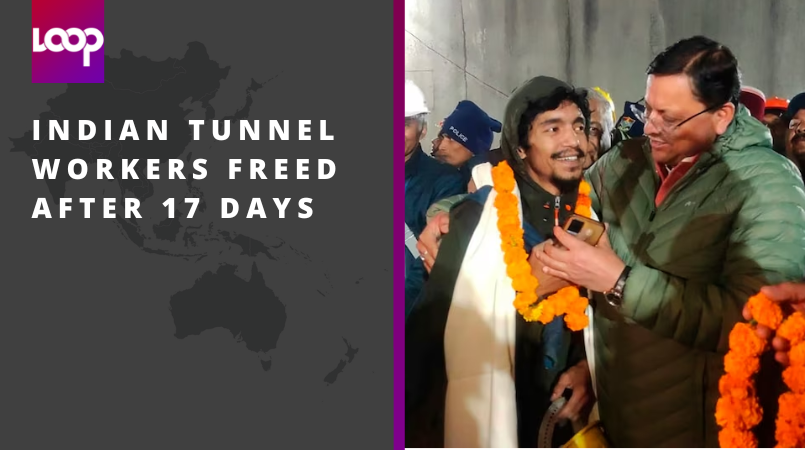
All 41 construction workers who were trapped in a collapsed mountain tunnel in northern India for more than two weeks have been pulled out, bringing an end to a drawn-out rescue mission that had grabbed the world's attention for days.
A crowd of local residents, gathered around the tunnel, erupted in joy and shouted slogans of "Bharat Mata ki Jai", or "Long live mother India," and set off firecrackers in celebration as the men were rescued.
Officials presented the first rescued workers with garlands made of flowers, hanging them around their necks as the crowd cheered.
Nitin Gadkari, the minister of road transport and highways, said on X, formerly known as Twitter, that he was "completely relieved and happy" after all workers were rescued from the Silkyara Tunnel in Uttarkashi following an ordeal that lasted 17 days.
"I am very happy that all the 41 trapped workers have come out and their lives have been saved," he said in a video message, and added that:
"This was a well-coordinated effort by multiple agencies, marking one of the most significant rescue operations in recent years."
The workers were pulled out through a passageway made of welded pipes that rescuers previously pushed through dirt and rocks. They will each have an initial health check-up at a temporary medical camp set up inside the 13-metre-wide tunnel.
One of the rescuers, Devender, who only gave his first name, told the New Delhi Television channel that "the trapped workers were overjoyed when they spotted us in the tunnel. Some rushed toward me and hugged me."
The massive rescue mission had many on edge. The workers became trapped on November 12, when a landslide caused a portion of the 4.5-kilometre tunnel they were building in Uttarakhand state to collapse about 200 metres from the entrance.
They survived on food and oxygen supplied through narrow steel pipes.
Drilling by hand
Kirti Panwar, a state government spokesperson, said about a dozen men had worked overnight to manually dig through rocks and debris, taking turns to drill using hand-held drilling tools and clearing out the muck in what he said was the final stretch of the rescue operation.
Rescuers resorted to manual digging after the drilling machine broke down on Friday while drilling horizontally from the front because of the mountainous terrain of Uttarakhand.
The machine bored through about 47 metres out of approximately the 57-60 metres needed, before rescuers started to work by hand to create a passageway to evacuate the trapped workers.
By Tuesday, they had drilled through more than 58 metres . As dusk fell, families of those trapped underground gathered near the site of the accident, anxiously waiting to see their loved ones emerge from the tunnel.
Among them was Jaimal Singh who was looking forward to seeing his brother Gabbar Singh, who was trapped inside.
"Even nature looks cheerful today … the weather is good. Let's hope this ends soon," he told the Press Trust of India news agency, before the successful extraction.
Most of the trapped workers are migrant labourers from across the country. Many of their families have travelled to the location, where they have camped out for days to get updates on the rescue effort and in hopes of seeing their relatives soon.
As the operation unfolded, the trapped workers were supplied with hot meals through a 15-centimetre pipe after days of surviving only on dry food sent through a narrower pipe.
They were getting oxygen through a separate pipe, and more than a dozen doctors, including psychiatrists, were at the site, monitoring their health.
The tunnel the workers were building was designed as part of the Chardham all-weather road, which will connect various Hindu pilgrimage sites.
Some experts say the project, a flagship initiative of the Modi government, will exacerbate fragile conditions in the upper Himalayas, where several towns are built atop landslide debris.
Large numbers of pilgrims and tourists visit Uttarakhand's many Hindu temples, with the number increasing over the years because of the continued construction of buildings and roadways.
AP, ABC News
